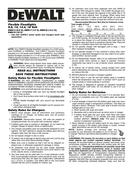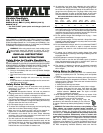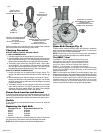Flexible Floodlights
9.6, 12, 14.4, 18 Volt
DW913 (9.6 V), DW917 (12 V), DW918 (14.4 V),
DW919 (18 V)
– Use with D
E
WALT power packs and chargers (both sold
separately).
NOTE: Your DW913 flexible floodlight operates on a 9.6V power
pack (DW9061 or DW9062). Your DW917 flexible floodlight
operates on a 12V power pack (DW9071 or DW9072). Your DW918
flexible floodlight operates on a 14.4V power pack (DW9091). Your
DW919 flexible floodlight operates on a 18V power pack (DW9095
or DW9096). Power packs are sold separately.
WARNING: When using electric tools, basic safety precau-
tions should always be followed to reduce risk of fire,
electric shock, and personal injury, including the following:
READ ALL INSTRUCTIONS
SAVE THESE INSTRUCTIONS
Safety Rules for Flexible Floodlights
WARNING: DO NOT OPERATE FLASHLIGHT or charger
NEAR FLAMMABLE LIQUIDS OR IN GASEOUS OR EXPLOSIVE
ATMOSPHERES. INTERNAL SPARKS MAY IGNITE FUMES. Do
not expose Flexible floodlight or charger to rain or damp areas.
WARNING: Lens and bulb become hot during use.
• During or immediately after use, don’t lay flexible floodlight
flat on lens surface.
• Don’t touch lens surface when bulb is lit or immediately after
use.
• Handle flexible floodlight with care around any flammable
surface.
• If bulb has been lit, let flexible floodlight cool for several min-
utes before changing bulb.
Safety Rules for Chargers
1. Before using charger, read all instructions and cautionary
markings on (1) charger, (2) battery pack, and (3) product
using battery pack.
2. DANGER: Electrocution hazard. 120 volts are present at
charging terminals. Do not probe with conductive objects.
3. If battery pack case is cracked or damaged, do not insert into
charger. Danger of electric shock or electrocution.
4. The charger and battery pack are specifically designed to work
together. DO NOT attempt to charge the battery pack with any
chargers other than the ones in this manual.
5. Do not expose charger to rain or snow.
6. To reduce risk of damage to electric plug and cord, pull by plug
rather than cord when disconnecting charger.
7. Make sure cord is located so that it will not be stepped on,
tripped over, or otherwise subjected to damage or stress.
8. An extension cord should not be used unless absolutely
necessary. Use of improper extension cord could result in risk
of fire, electric shock, or electrocution.
9. Two wire cords can be used with 2 or 3 wire extension cords.
Only round jacketed extension cords should be used, and we
recommend that they be listed by Underwriters Laboratories
(U.L.) (C.S.A. in Canada.) The letters WA on the cord jacket
indicate that the cord is suitable for outdoor use.
10. An extension cord must have adequate wire size (AWG or
American Wire Gauge) for safety. The smaller the gauge num-
ber of the wire, the greater the capacity of the cable, that is 16
gauge has more capacity than 18 gauge. When using more
than one extension to make up the total length, be sure each
individual extension contains at least the minimum wire size.
Recommended Minimum Wire Size for Extension Cords
Total Length of Cord
25 ft. 50 ft. 75 ft. 100 ft. 125 ft. 150 ft. 175 ft.
7.6 m 15.2 m 22.9 m 30.5 m 38.1 m 45.7 m 53.3 m
Wire Size AWG
18 18 16 16 14 14 12
11. The charger is ventilated through slots in the top and the bot-
tom of the housing. Do not place any object on top of the charg-
er or place the charger on a soft surface that might block the
ventilation slots and result in excessive internal heat. Place the
charger in a position away from any heat source.
12. Do not operate charger with damaged cord or plug — have
them replaced immediately.
13. Do not operate charger if it has received a sharp blow, been
dropped, or otherwise damaged in any way; take it to an autho-
rized D
E
WALT service center.
14. Do not disassemble charger; take it to an authorized D
E
WALT
service center when service or repair is required. Incorrect
reassembly may result in a risk of electric shock, electrocution
or fire.
15. To reduce risk of electric shock, unplug charger from outlet
before attempting any cleaning. Removing the battery pack will
not reduce this risk.
16. NEVER attempt to connect 2 chargers together.
17. DO NOT store or use the tool and battery pack in locations
where the temperature may reach or exceed 105°F (such as
outside sheds or metal buildings in summer).
18. The charger is designed to operate on standard household
electrical power (120 volts). Do not attempt to use it on any
other voltage!
Safety Rules for Batteries
1. Do not incinerate the battery pack even if it is severely dam-
aged or is completely worn out. The battery pack can explode
in a fire.
2. A small leakage of liquid from the battery pack cells may occur
under extreme usage or temperature conditions. This does not
indicate a failure. However, if the outer seal is broken and this
leakage gets on your skin:
a. Wash quickly with soap and water.
b. Neutralize with a mild acid such as lemon juice or vinegar.
c. If battery liquid gets into your eyes, flush them with clean
water for a minimum of 10 minutes and seek immediate
medical attention. (Medical note: The liquid is 25-35%
solution of potassium hydroxide.)
3. Never attempt to open the battery pack for any reason. If the
plastic housing of the battery pack breaks or cracks, immedi-
ately discontinue use and do not recharge.
NOTE: Battery storage and carrying caps are
provided for use whenever the battery is out of the tool
or charger. Remove cap before placing battery in charger
or tool.
WARNING: Fire hazard. Do not store or carry battery so that
metal objects can contact exposed battery terminals. For
example, do not place battery in aprons, pockets, tool boxes, prod-
uct kit boxes, drawers, etc., with loose nails, screws, keys, etc. with-
out battery cap. Transporting batteries can possibly cause fires
if the battery terminals inadvertently come in contact with
conductive materials such as keys, coins, hand tools and the
like. The US Department of Transportation Hazardous Material
Regulations (HMR) actually prohibit transporting batteries in
commerce or on airplanes (i.e., packed in suitcases and carry-on
luggage) UNLESS they are properly protected from short circuits.
So when transporting individual batteries, make sure that the


















